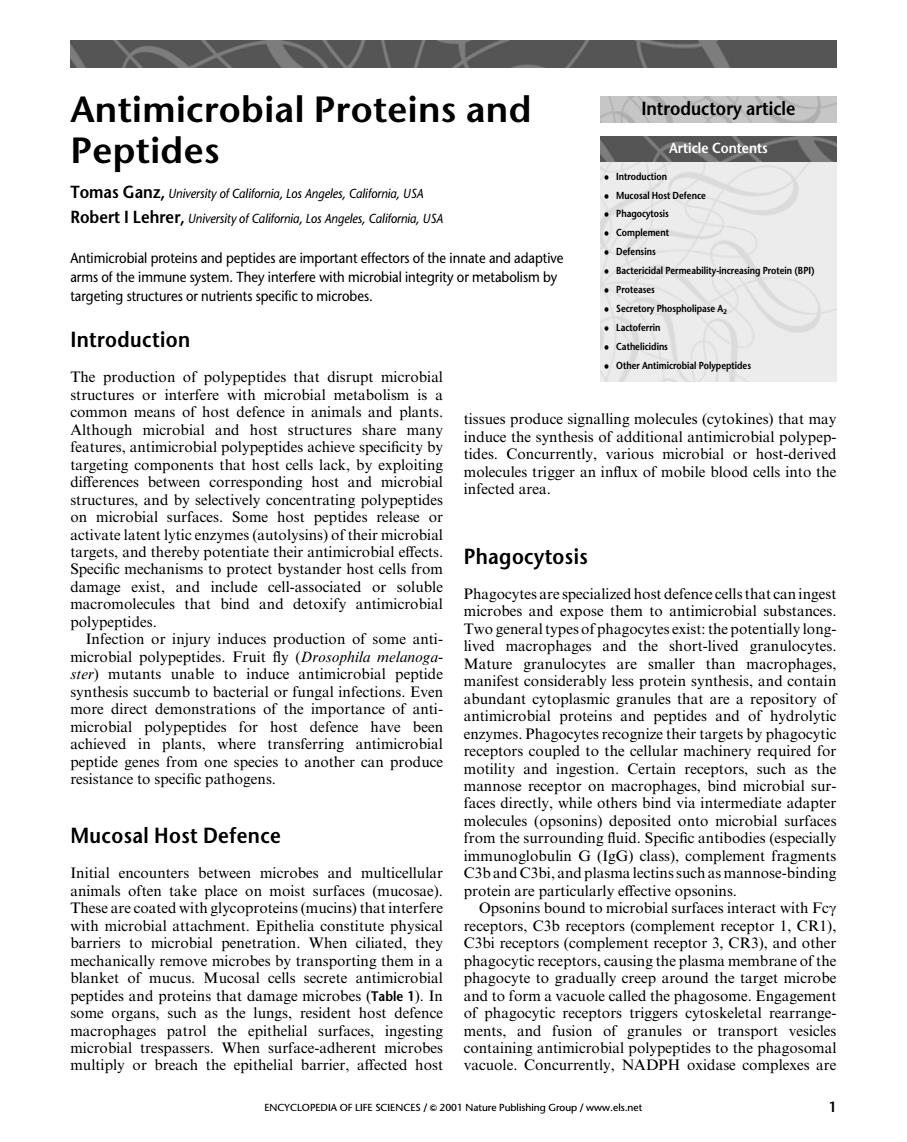正在加载图片...

Antimicrobial Proteins and Introductory article Peptides Artice Contents Tomas Ganz,University of Califomia,Los Angeles,Califomio,USA RobertLehrer,University of Califomio,Los Angeles,Califorio,USA Antimicrobial proteins and peptides are important effectors of the innate and adaptive arms of the immune system.They interfere with microbial integrity or metabolism by ing Protein (BPI targeting structures or nutrients specific to microbes. .Se ry Phospholipase Az Introduction ·Other Antin The production of polypeptides that disrupt microbial structures or interfere with microbial metabolism is a host defence in animals and plants tides.Concurrently,various microbial or host-derived differences between corresponding host and microbial molecules trigger an influx of mobile blood cells into the nfected area Structuresand some host peptideporease or on mic re targets.and thereby potentiate their antimicrobial effects Specific mechanisms to protect bystander host cells from Phagocytosis oetoor injury induces production of some anti- Two generaltypesof phagocytesexist:the potentially long microbial polypeptides.Fruit fly (Drosophila melanoga ived macrophages and the short-lived granulocytes ster)mutants unable to induce antimicr obal peptide Mature granulocy are smallerhan macrophages syn e ues that ar microbial polypeptides for host defence have been antimicrobial proteins and peptides and of hydrolytic achieved in plants,where transferring antimicrobial ece inery require on Certa faces directly,while others bind via intermediate adapter Mucosal Host Defence rom the s Initial encounters between microbes and multicellular Cshand Csi.and plasmalectinssuch as mannose-binding animals often take place on moist surfaces (mucosae). protein are particularly effective opsonins. with cmicrobial attag zlycoproteins (mucins thst ishvacre Opsonins bound to microbial surfaces interact with Fey Ep tute physica eptors.C3b echanically remove microbes by transporting the causing the plasma membrane of the blanket of mucus.Mucosal cells secrete antimicrobial around the target microbe peptides and proteins that damage microbes(Tabl and to form a some organs,such as the lungs. ceptors trigger s cyt rearrange e-adherent microbe containin granule tides to the ph multiply or breach the epithelial barrier,affected host vacuole.Concurrently,NADPH oxidase complexes are ENCYCLOPEDIA OF LIFE SCIENCES/2001 Na .els net 1Antimicrobial Proteins and Peptides Tomas Ganz, University of California, Los Angeles, California, USA Robert I Lehrer, University of California, Los Angeles, California, USA Antimicrobial proteins and peptides are important effectors of the innate and adaptive arms of the immune system. They interfere with microbial integrity or metabolism by targeting structures or nutrients specific to microbes. Introduction The production of polypeptides that disrupt microbial structures or interfere with microbial metabolism is a common means of host defence in animals and plants. Although microbial and host structures share many features, antimicrobial polypeptides achieve specificity by targeting components that host cells lack, by exploiting differences between corresponding host and microbial structures, and by selectively concentrating polypeptides on microbial surfaces. Some host peptides release or activate latent lytic enzymes (autolysins) of their microbial targets, and thereby potentiate their antimicrobial effects. Specific mechanisms to protect bystander host cells from damage exist, and include cell-associated or soluble macromolecules that bind and detoxify antimicrobial polypeptides. Infection or injury induces production of some antimicrobial polypeptides. Fruit fly (Drosophila melanogaster) mutants unable to induce antimicrobial peptide synthesis succumb to bacterial or fungal infections. Even more direct demonstrations of the importance of antimicrobial polypeptides for host defence have been achieved in plants, where transferring antimicrobial peptide genes from one species to another can produce resistance to specific pathogens. Mucosal Host Defence Initial encounters between microbes and multicellular animals often take place on moist surfaces (mucosae). These are coated with glycoproteins (mucins) that interfere with microbial attachment. Epithelia constitute physical barriers to microbial penetration. When ciliated, they mechanically remove microbes by transporting them in a blanket of mucus. Mucosal cells secrete antimicrobial peptides and proteins that damage microbes (Table 1). In some organs, such as the lungs, resident host defence macrophages patrol the epithelial surfaces, ingesting microbial trespassers. When surface-adherent microbes multiply or breach the epithelial barrier, affected host tissues produce signalling molecules (cytokines) that may induce the synthesis of additional antimicrobial polypeptides. Concurrently, various microbial or host-derived molecules trigger an influx of mobile blood cells into the infected area. Phagocytosis Phagocytes are specialized host defence cells that can ingest microbes and expose them to antimicrobial substances. Two general types of phagocytes exist: the potentially longlived macrophages and the short-lived granulocytes. Mature granulocytes are smaller than macrophages, manifest considerably less protein synthesis, and contain abundant cytoplasmic granules that are a repository of antimicrobial proteins and peptides and of hydrolytic enzymes. Phagocytes recognize their targets by phagocytic receptors coupled to the cellular machinery required for motility and ingestion. Certain receptors, such as the mannose receptor on macrophages, bind microbial surfaces directly, while others bind via intermediate adapter molecules (opsonins) deposited onto microbial surfaces from the surrounding fluid. Specific antibodies (especially immunoglobulin G (IgG) class), complement fragments C3b and C3bi, and plasma lectins such as mannose-binding protein are particularly effective opsonins. Opsonins bound to microbial surfaces interact with Fcg receptors, C3b receptors (complement receptor 1, CR1), C3bi receptors (complement receptor 3, CR3), and other phagocytic receptors, causing the plasma membrane of the phagocyte to gradually creep around the target microbe and to form a vacuole called the phagosome. Engagement of phagocytic receptors triggers cytoskeletal rearrangements, and fusion of granules or transport vesicles containing antimicrobial polypeptides to the phagosomal vacuole. Concurrently, NADPH oxidase complexes are Article Contents Introductory article . Introduction . Mucosal Host Defence . Phagocytosis . Complement . Defensins . Bactericidal Permeability-increasing Protein (BPI) . Proteases . Secretory Phospholipase A2 . Lactoferrin . Cathelicidins . Other Antimicrobial Polypeptides ENCYCLOPEDIA OF LIFE SCIENCES / & 2001 Nature Publishing Group / www.els.net 1